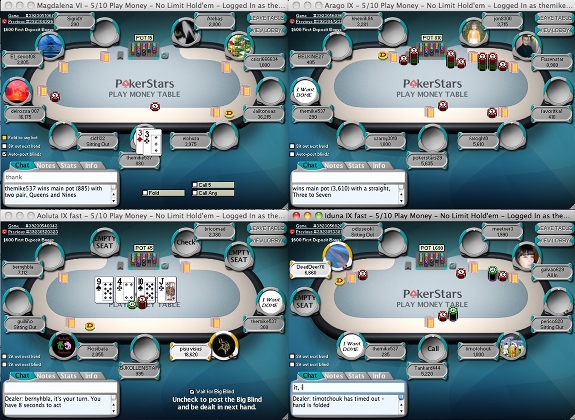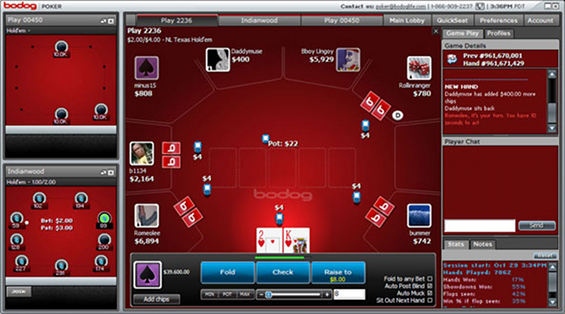Beginner's Guide:
- What is Internet Poker?
- Is Internet Poker Legal?
- Is Internet Poker Safe/Fair?
- Choosing a Poker Site
- Poker Bonuses
- Internet Poker for Windows
- Internet Poker for Macs
- Creating a Player Account
- Play vs. Real Money Poker
- How to Deposit Money
- Cash Games vs. MTTs/SNGs
- Browsing the Poker Lobby
- Using the Poker Table
- Internet Poker Etiquette
- Multi-Tabling
- How to Cash Out Money
- Internet Poker FAQ
- Poker Lingo and Terms
- Further Reading
Multi-Tabling Explained
“Multi-tabling” is a new poker term, as the act of multi-tabling has only been possible since the dawn of Internet poker (roughly a decade ago). This article is going to define “multi-tabling”, explain exactly how players can multi-table, look at some advantages and disadvantages of multi-tabling, and examine how different Internet poker rooms handle multi-tabling.
What is Multi-Tabling?
The term multi-tabling describes the act of playing at more than one poker table at the same time. Poker players who play in a live casino will never have the opportunity to multi-table, because players have to be physically seated at their table to receive a hand.
On the other hand, Internet poker rooms don’t require players to physically sit at any single table, so players can open up multiple tables and sit at all of them. If you are struggling to understand what multi-tabling is, check out the screen shot below to see an example of a player multi-tabling at PokerStars.com.
As you can see, player “themike537” is seated at four different tables at the same time. PokerStars features a traditional multi-tabling setup, where each table opens in its own window. Later on we will discuss some other multi-tabling setups used by various Internet poker rooms.
How to Multi-Table
At most poker sites, multi-tabling is extremely simple. To open your first table, locate the table in the poker room’s lobby and double click the listing. To open more tables, locate the new tables in the poker room’s lobby and double click them too. Each of the tables will open in a new window on your computer screen (unless the poker site features a table-in-table system, which is discussed below).
Many poker sites allow you to resize the tables once they are all open, so you can configure your screen as you wish. Sites like PokerStars and Full Tilt Poker allow players to cascade, tile, or custom-resize each table to find the perfect layout.
Insider’s Tip – If you plan on playing more than four tables at once, we recommend buying a second computer monitor to provide you with a “dual monitor” setup. This will give you much more screen space and will allow you to play at least twice as many tables.
Advantages of Multi-Tabling
Multi-tabling brings about quite a few advantages, including:
- Increased number of hands per hour. If you are a winning player, you want to maximize your hands per hour so you can win as much money as possible. Be careful to not overwhelm yourself though, because if you spread yourself too thin you may lose your edge over the other players.
- Decreased boredom. If you are a new poker player sitting at only one table, you may get bored during a bad run of cards and start playing mediocre hands. By sitting at multiple tables you increase your chances of having at least one decent hand every round.
Disadvantages of Multi-Tabling
There are also some disadvantages for multi-tabling, including:
- Lack of focus. If you are playing too many tables at one time, you may “zone out” and simply play ABC poker. At the low stakes this isn’t the worst thing, but if you are playing higher stakes you will need to occasionally make more sophisticated plays to outsmart your opponents.
- Miss-clicks. Every time it is your turn to act at one of your tables, that table automatically “pops up” on the front of your screen. This can become problematic if you are about to click something in a different window, and your table pops up right as you click. Most of the time you will click thin air, but once in a while you will accidentally click to Raise, Call an all-in, or even Fold a big hand like pocket Aces, which could end up costing you a lot of money.
- Loss of social interaction. Although only poker is naturally a less social game than live poker, there is still the opportunity to talk with your opponents using the chat box. However, if you are playing four or more tables, it is pretty much impossible to hold a conversation as well as monitor each of your games, so any potential social interaction goes out the window.
Multi-Tabling Methods
As we have mentioned throughout this article, certain poker rooms use different methods for multi-tabling:
The Traditional Method
Most poker sites use the “traditional method” of multi-tabling, which is simply to open up a new window for each table the player wishes to join. Most players prefer this method because you can play 16+ tables at once, and you can arrange the tables on your screen as you see fit. The only disadvantage of the traditional method is the increased likelihood of a miss-click as tables pop to the front of your screen.
Here is a screen shot of the traditional method at PokerStars.com:
You may recognize this screen shot from earlier in the article.
The Table in Table Method
The alternative to the traditional method is the “table in table” method. All of your tables are open inside of the same window, with one large table in the middle of the window and up to three smaller tables on the left of the window.
When action is on you at any of the tables, that table comes to the center and the table that was in the center goes to the left. The effect of this is that you can see all of your tables at once, but you can only play up to four tables at the same time. Here is a screen shot of the table in table method at Bovada.lv:
Most players prefer the traditional method because it gives you more freedom to arrange your screen, but some players prefer the table in table method because you don’t have to have multiple windows open on your computer.
Thank you for reading our multi-tabling article! We hope you now have a better understanding of what multi-tabling is, how you can multi-table, the advantages and disadvantages of multi-tabling, and the various methods for multi-tabling.
Next Article » How to Cash Out


